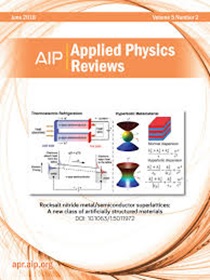MXene as a hydrogen storage material
IF 11.6
1区 物理与天体物理
Q1 PHYSICS, APPLIED
引用次数: 0
Abstract
Traditional hydrogen storage materials rely mainly on chemical adsorption (such as metal hydrides and chemical hydrides) or physical adsorption (such as metal–organic frameworks, activated carbon, zeolites, and other high-specific surface area materials) to achieve the storage and release of hydrogen. However, these materials struggle to simultaneously meet the technical requirements of high-capacity, rapid, and reversible hydrogen absorption and desorption under room temperature and atmospheric pressure. In recent years, both theoretical predictions and experimental research have indicated that nontraditional hydrogen storage materials based on hybrid adsorption mechanisms (such as physical adsorption, chemical adsorption, Kubas-type interactions, static electric polarization, and weak chemical adsorption)—namely, MXene materials—are promising for rapid and high-capacity hydrogen storage under normal conditions. This review aims to focus on the intrinsic principles of the diverse hybrid mechanisms of MXene materials and recent research progress of MXene as a hydrogen carrier. By detailed analysis of their structural characteristics, surface properties, and the specific mechanisms of interaction with hydrogen, it strives to deepen the understanding of the physicochemical principles of MXene materials as a hydrogen storage material.MXene作为储氢材料
传统的储氢材料主要依靠化学吸附(如金属氢化物和化学氢化物)或物理吸附(如金属有机骨架、活性炭、沸石等高比表面积材料)来实现氢的储存和释放。然而,这些材料很难同时满足室温常压下大容量、快速、可逆的吸氢和解吸的技术要求。近年来,理论预测和实验研究都表明,基于混合吸附机制(如物理吸附、化学吸附、kubas型相互作用、静电极化和弱化学吸附)的非传统储氢材料,即MXene材料,在正常条件下具有快速、高容量储氢的前景。本文综述了MXene材料各种杂化机理的内在原理以及MXene作为氢载体的最新研究进展。通过详细分析MXene材料的结构特征、表面性质以及与氢相互作用的具体机理,努力加深对MXene材料作为储氢材料的物理化学原理的理解。
本文章由计算机程序翻译,如有差异,请以英文原文为准。
求助全文
约1分钟内获得全文
求助全文
来源期刊

Applied physics reviews
PHYSICS, APPLIED-
CiteScore
22.50
自引率
2.00%
发文量
113
审稿时长
2 months
期刊介绍:
Applied Physics Reviews (APR) is a journal featuring articles on critical topics in experimental or theoretical research in applied physics and applications of physics to other scientific and engineering branches. The publication includes two main types of articles:
Original Research: These articles report on high-quality, novel research studies that are of significant interest to the applied physics community.
Reviews: Review articles in APR can either be authoritative and comprehensive assessments of established areas of applied physics or short, timely reviews of recent advances in established fields or emerging areas of applied physics.
 求助内容:
求助内容: 应助结果提醒方式:
应助结果提醒方式:


